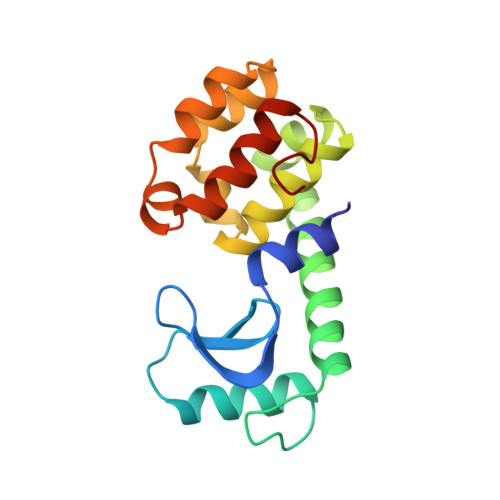Structures of randomly generated mutants of T4 lysozyme show that protein stability can be enhanced by relaxation of strain and by improved hydrogen bonding via bound solvent.
Pjura, P., Matthews, B.W.(1993) Protein Sci 2: 2226-2232
- PubMed: 8298466
- DOI: https://doi.org/10.1002/pro.5560021222
- Primary Citation of Related Structures:
129L, 130L, 131L - PubMed Abstract:
The structures of three mutants of bacteriophage T4 lysozyme selected using a screen designed to identify thermostable variants are described. Each of the mutants has a substitution involving threonine. Two of the variants, Thr 26-->Ser (T26S) and Thr 151-->Ser (T151S), have increased reversible melting temperatures with respect to the wild-type protein. The third, Ala 93-->Thr (A93T), has essentially the same stability as wild type. Thr 26 is in the wall of the active-site cleft. Its replacement with serine results in the rearrangement of nearby residues, most notably Tyr 18, suggesting that the increase in stability may result from the removal of strain. Thr 151 in the wild-type structure is far from the active site and appears to sterically prevent the access of solvent to a preformed binding site. In the mutant, the removal of the methyl group allows access to the solvent binding site and, in addition, the Ser 151 hydroxyl rotates to a new position so that it also contributes to solvent binding. Residue 93 is in a highly exposed site on the surface of the molecule, and presumably is equally solvent exposed in the unfolded protein. It is, therefore, not surprising that the substitution Ala 93-->Thr does not change stability. The mutant structures show how chemically similar mutations can have different effects on both the structure and stability of the protein, depending on the structural context. The results also illustrate the power of random mutagenesis in obtaining variants with a desired phenotype.(ABSTRACT TRUNCATED AT 250 WORDS)
Organizational Affiliation:
Institute of Molecular Biology, Howard Hughes Medical Institute, University of Oregon, Eugene 97403.
















